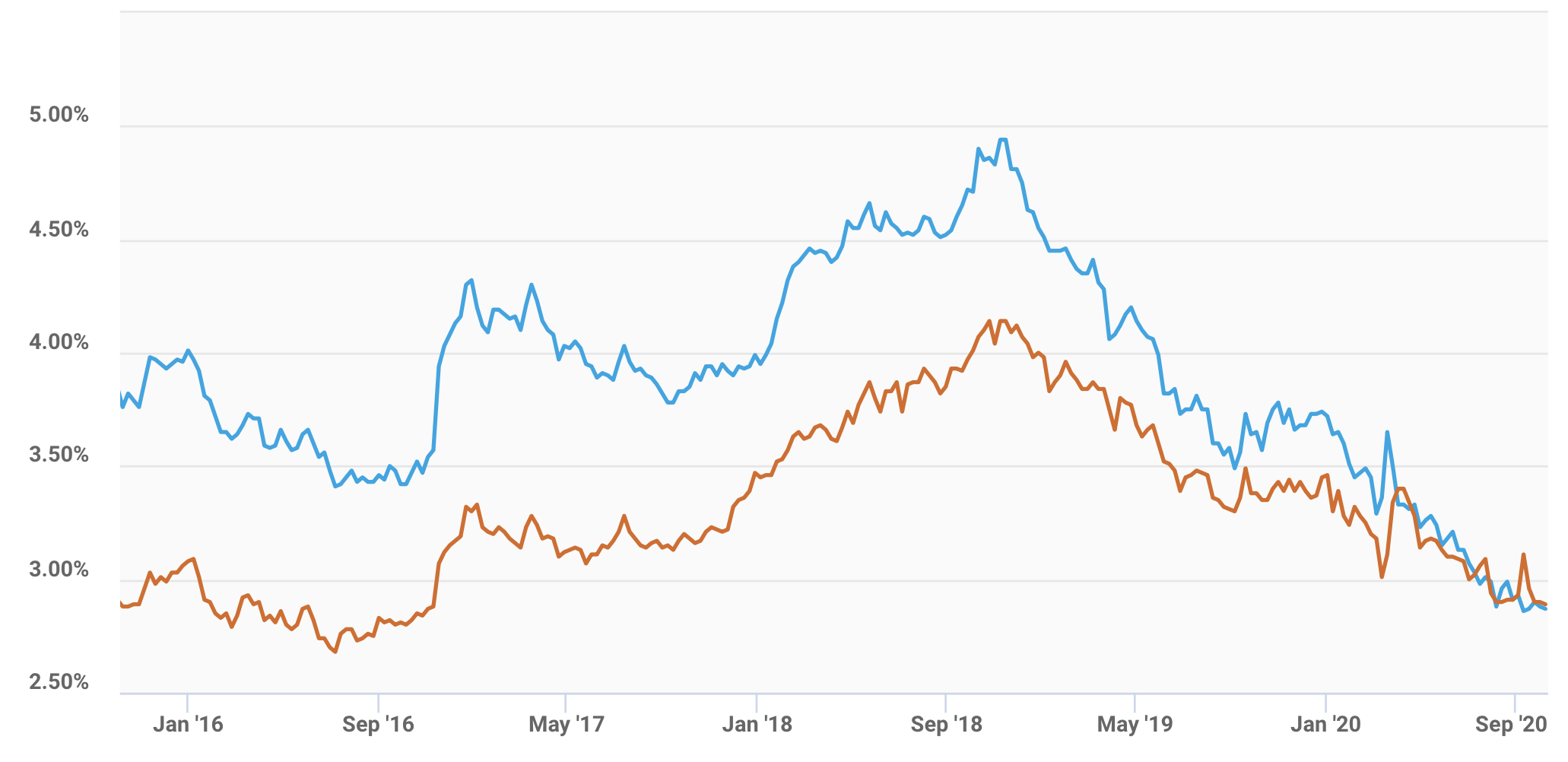Home buyers with variable income often wonder if they can qualify for a mortgage loan…
California Mortgage Rates Trends: 30-year Fixed Better Than ARM?
California mortgage rate trends over the past year reveal an interesting change that began a few months back. For years, short-term adjustable rate mortgage (ARM) loans tended to offer lower rates than the more commonly used 30-year fixed mortgage. But that began to change, back in April of 2020.
Today, the average rate for a 30-year fixed home loan in California and nationwide is comparable (and sometimes even lower) than the average interest rate for an ARM loan.
This is good news for borrowers across California. It means you could have the “best of both worlds.” You could enjoy the long-term stability and predictability of a 30-year fixed-rate mortgage, while getting a relatively low interest rate at the same time.
California Mortgage Rate Trends as of Fall 2020
The chart below puts all of this into perspective. This chart was created by Freddie Mac, the government-sponsored buyer of home loans. It’s based on their Primary Mortgage Market Survey (PMMS), which has been tracking home loan interest rates in the U.S. since 1971.
This chart shows two important rates trends for California and nationwide:
- The blue line represents the average rate for a 30-year fixed mortgage.
- The red line represents the average rate for a 5-year adjustable / ARM loan.
When viewing this chart, two trends will jump out at you right away:
First, you’ll notice that 30-year mortgage rates in California and across the U.S. have declined sharply over the past couple of years. In fact, the average rate for a 30-year home loan recently fell to an all-time record low (to date) of 2.87%.
The second thing you’ll notice is that 30-year mortgage rates are now competing with the 5-year ARM loan. Historically, the 5-year adjustable (ARM) loan used to offer a much lower interest rate than the more popular 30-year fixed mortgage product.
Zooming this chart out to show 10 years worth of data would reveal the same thing. For years, the 5-year ARM offered a lower rate that the 30-year fixed. But not anymore. Starting in April 2020, shifting demand from investors within the secondary mortgage market led to a narrowing of the gap between the two products.
This is a significant trend, one that could benefit a lot of home buyers and refinancing homeowners going forward. If these mortgage rate trends persist, California borrowers could continue to have the “best of both worlds” in 2021.
ARM vs. Fixed: How to Choose
Here’s a quick review for those who aren’t familiar with the terminology being used here:
- 30-year fixed-rate mortgage: This is the most popular type of home loan in California and nationwide. As its name suggests, it holds the same interest rate for the full term of the loan (which is 30 years in this case). It offers the most stability and helps borrowers to avoid payment fluctuations over time.
- 5-year ARM: This is an adjustable mortgage loan that starts off with a fixed interest rate for the first five years of the repayment window. After that initial period, the rate will begin to adjust once per year. It can adjust upward or downward, depending on market trends at the time of adjustment.
Related: Types of home loans in California
In the past, some borrowers have chosen the short-term ARM over the 30-year fixed loan, in order to secure a lower interest rate. The downside of the ARM is that it can adjust to a possibly higher mortgage rate down the road. But for some borrowers, the short-term savings made up for the long-term unpredictability.
Today, however, this is a much easier decision to make. California mortgage rate trends in 2020 have deviated from their traditional pattern. As you can see in the above chart, the average rate for a 30-year fixed mortgage has recently been trending closely with the 5-year ARM. And that makes a strong cased for going fixed, instead of adjustable.
What’s the Outlook for 2021?
In 2020, California mortgage rate trends have favored borrowers in two ways. First, they’ve come down considerably from a year ago. Secondly, the rates for 30-year fixed home loans have become increasingly competitive, even dipping below ARM loan interest rates on occassion.
It would be nice to say these mortgage trends will last for a good long while — and that borrowers in California will continue to benefit from them well into 2021.
But the truth is, we just don’t know. One notable forecast predicted that the average rate for a 30-year mortgage could inch upward, as we move into 2021.
In a long-range forecast issued back in June, the research team at Freddie Mac predicted that 30-year fixed mortgages in California and nationwide would average 3.2% in 2021. In a more recent forecast from September 2020, the Mortgage Bankers Association predicted much the same. The MBA forecast suggested that 30-year loan rates would trend upward to 3.1% by the first quarter of 2021, and increase slightly after that.
Of course, these are just predictions. They’re the equivalent of an educated guess. The bottom line is that mortgage rate trends in California have been favorable to borrowers, and that includes having a much more competitive 30-year fixed home loan.


